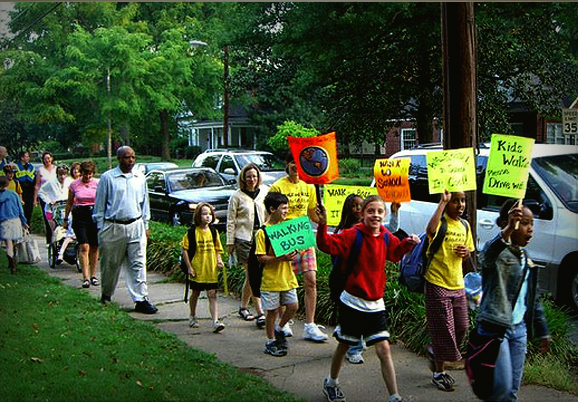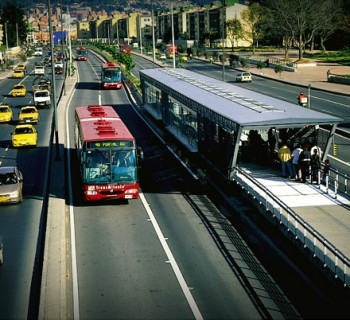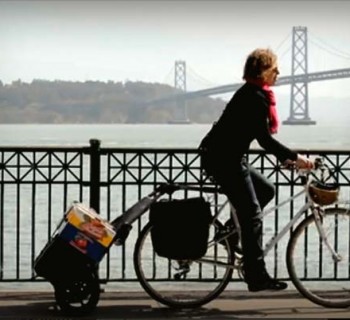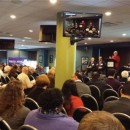The “walking school bus” snakes through the neighborhood near Horizon Elementary school to get students there safely and more healthily than if they’d been driving. Sometimes the principal leads it, starting on foot from the end of the route and encouraging kids – and adults – to join the group before the morning bell.
The “bus” is one of the efforts of the Safe Routes to School initiative of the Michigan Fitness Foundation. And it’s an example of how safer, healthier, connected communities can be created through policy and government funding.
"We are up against the shifting paradigm of this day and age. In the late 1960s, 50 percent of kids were walking to school and just 10 to 15 percent were driven. It’s completely flipped now." ~Megan Thomas
Megan Thomas, the director of Michigan’s Safe Routes to School, spoke with Mode Shift to discuss how the program helps districts and communities improve infrastructure through grants and promote programs like the walking school bus, for example, to improve children’s and communities’ health.
Since 2007, Safe Routes to School has funded $18 million in Michigan projects.
Mode Shift: What does Safe Routes to School (SRTS) do?
Megan Thomas: We are strictly held by what the statutory purposes of the program are at the federal level: to encourage and enable children to walk and bicycle to school; to make walking and riding to school a safe and more attractive alternative for a healthy lifestyle; to facilitate planning, development and implementation of programs and activities that will improve safety, reduce traffic and air and traffic pollution.
MS: What are some of the specifics of your program?
MT: We like to say we have the five “Es”: education, enforcement, encouragement, engineering and evaluation. Sidewalks are part of the engineering piece. There’s the education piece, the education of the kids, the parents and the community. There’s the enforcement of it. Some schools choose to not have cars right around schools or to set up certain traffic slowing patterns. And there’s the encouragement. Setting up things like mileage clubs, tags for a certain number of miles walked to and from school. Sometimes they are silly and fun things like a golden shoe award.
MS: Where does your money come from?
MT: It’s an international initiative that the feds picked up and started funding through the Transportation Bill. Each state has to have a state coordinator. Here the Michigan Department of Transportation subcontracts to administer the federal grant and we at Michigan Fitness Foundation work with several subpartners: the Wayne State University Transportation Research Group, Michigan State Land Policy Institute, the Michigan Department of Community Health and the Michigan Association of Planners, to name a few.
MS: In addition to the walking school bus, what other programs do you have?
MT: With MDOT, we go into communities. We help them develop an action planning process, look at doing an audit, for example, an assessment of the routes around schools, what do they need to do to make them safe? Some of those things communities can do themselves very easily. For some of them, they might have to get funding elsewhere.
MS: Does SRTS pay for sidewalks or other infrastructure?
MT: We can fund some projects. For example, if there are no sidewalks on busy roads used by kids. That’s where MDOT can come in, and we help facilitate that process and put in some sidewalks or develop better crosswalks for the children.
MS: What is your biggest obstacle?
MT: We are up against the shifting paradigm of this day and age. In the late 1960s, 50 percent of kids were walking to school and just 10 to 15 percent were driven. It’s completely flipped now. We’ve got more cars on the road, more wear-and-tear on the roads. Around schools they estimate that about 7 to 14 percent of the morning commuting is people taking their kids to school, so you can imagine what the emissions are like around the schools. That translates to health issues.
MS: How will SRTS be taking a more broad-based approach?
MT: One of the things that we would like to see more of is the community, the township, the municipality, getting together with the school district and getting them to work together on comprehensive transportation planning. And we would like to build walking in as part of the transportation plan for every school district.
Want to help make routes to school safer for kids? Join ongoing efforts to patrol and clean up routes in Detroit school districts.










